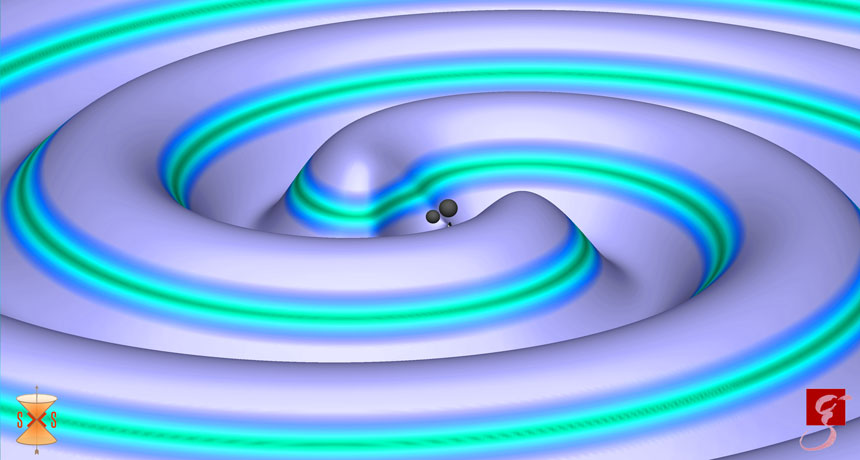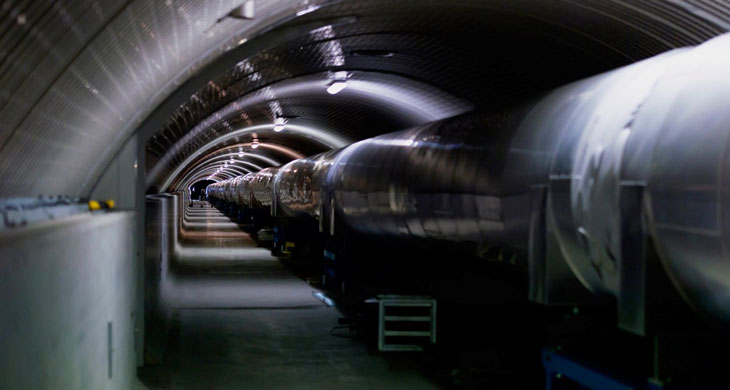
WAVE HELLO Gravitational waves have been traced closer to their origins than ever before. Emitted when two black holes spiraled inward and crashed together (simulation shown), the ripples were detected by the LIGO and Virgo detectors on August 14.
S. Ossokine, A. Buonanno. T. Dietrich/Max Planck Institute for Gravitational Physics, R. Haas/NCSA, Simulating eXtreme Spacetimes project
- More than 2 years ago
The gravitational wave paparazzi have tracked down the cosmic neighborhood of two merging black holes. Scientists pinpointed the region in the sky where the two black holes violently melded and kicked up swirls of the spacetime ripples, locating their stomping grounds more precisely than ever before.
Researchers from LIGO — the Advanced Laser Interferometer Gravitational-Wave Observatory — and its sister experiment, Advanced Virgo, spotted the ripples on August 14. The team announced the finding September 27 at a news conference at a meeting of the G7 science ministers in Turin, Italy, and in a paper accepted in Physical Review Letters.
It’s the first gravitational wave sighting to be made with three detectors: LIGO’s two detectors (in Livingston, La., and Hanford, Wash.) and Virgo’s detector near Pisa, Italy. “The three-detector network really opens up a new potential and we are going to make the most of that potential in the future,” said Virgo scientist Frédérique Marion, of the Laboratoire d’Annecy de Physique des Particules in France.
The trio of detectors allowed scientists to trace the source of the waves to a spot in the sky with an area of just 60 square degrees. Viewed in the night sky, the size of that region is about 300 times that of the full moon as seen from Earth. The ripples journeyed to Earth from about 1.8 billion light-years away, in a region near the constellation Eridanus in the southern sky.
Story continues after image

LIGO has previously detected three black hole crashes with its two detectors; in each case, scientists carved out a swath of sky from which the waves could have come, but could not discern a more specific cosmic birthplace. The newfound black holes were located within a region about a tenth the size of those associated with previous detections.
Because gravitational waves take time to complete the cross-planet jaunt from one detector to another, the three detectors spotted the signal at slightly different times. LIGO’s Livingston detector saw the waves first, followed by the LIGO Hanford detector 8 milliseconds later, and by the Virgo detector another 6 milliseconds after that. By analyzing these delays and the patterns of the ripples each detector saw, scientists were able to deduce what direction they came from.
Scientists estimated the colliding black holes’ masses at about 31 and 25 times the sun’s mass. During the collision, approximately three solar masses were converted into energy and radiated as gravitational waves, leaving behind a 53-solar-mass black hole.
The LIGO and Virgo detectors teamed up August 1 (SN Online: 8/1/17), when Virgo began officially taking data for the first time in its current, upgraded form. Previous incarnations of both LIGO and Virgo ran for years without detecting a whiff of spacetime wiggles. Now the detectors are finally sensitive enough to pick up the tiny tremors. The improved trio operated in tandem until August 25, when the detectors shut down for further improvements.
Story continues after graphic
Gravitational gotcha
With the Aug. 14 detection of spacetime ripples, scientists were able to home in on the location of gravitational wave‒flinging black holes more precisely than ever before, illustrated in lime green on a map of the sky. The regions associated with three previous detections and an unconfirmed hint are shown for comparison.

Virgo also allowed scientists to better test Einstein’s general theory of relativity. Because Virgo’s detector isn’t oriented parallel to the LIGO detectors, scientists could study the polarization of the waves — the specific pattern by which they stretch and squeeze spacetime — for the first time. “In the long run that’s a really big deal,” says physicist Clifford Will of the University of Florida in Gainesville, who was not involved with the detection. If unexpected kinds of stretching or squeezing were found, “it would kill general relativity, just like that. That would be the end.” But Einstein’s theory held its ground.
Scouting out the locales where black hole pairs live allows astronomers to look for light produced in the collision. Although most scientists expect that no light will be emitted in black hole dust-ups, some theories suggest otherwise. After the ripples were detected, telescopes scoured the spot, but observations came up empty.
Other kinds of collisions, however — between two remnants of stars called neutron stars — could produce light. Therefore, the new detection “is good preparation for what’s to come,” says physicist Emanuele Berti of the University of Mississippi in Oxford, who was not involved with the detection. Spotting light from a neutron star pileup could help scientists learn more about the extremely dense material that makes up neutron stars. In August, rumors began flying that scientists had detected such an event (SN Online: 8/25/17). If the rumor is true, Berti says, with two detections in one month, “they’ve made giant strides.”







